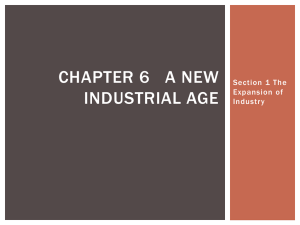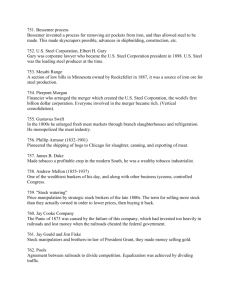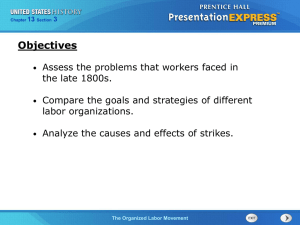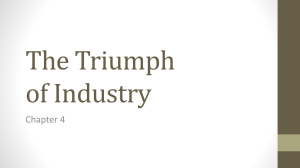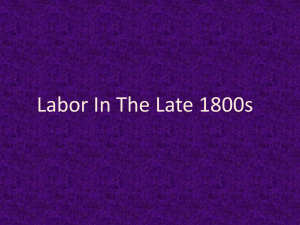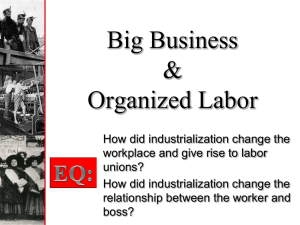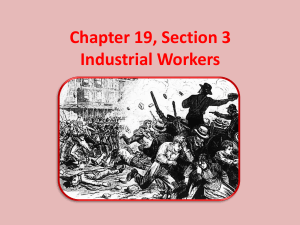Ch. 6, 8gr PowerPoint
advertisement
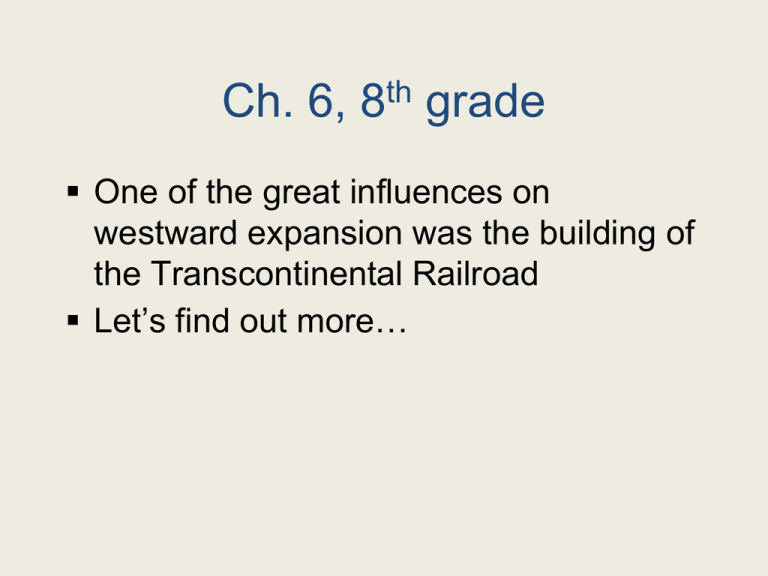
Ch. 6, 8th grade One of the great influences on westward expansion was the building of the Transcontinental Railroad Let’s find out more… Chapter 6, Section 1: The Growth of Industry Inventions that Encouraged the Growth of Industry Edison's electric light Bessemer steel process Edwin Drake's method for drilling for oil launched the oil industry http://www.history.com/shows/modernmarvels/videos/light-bulb-turns-night-intoday#light-bulb-turns-night-into-day The steel industry was important to the nation’s economic growth because steel was better than iron for use in building RR tracks. Edwin Drake • http://www.youtube.com/watch?v=D4sykoU WZ8g Section 1: The Growth of Industry a patent is a government document giving an inventor the exclusive right to make and sell his or her invention for a specific number of years A generator is a machine that a patent produces electric current U. S. Patents Granted 1790s → 276 patents issued. 1990s → 1,119,220 patents issued Section 1: The Growth of Industry American industry didn't grow at a steady pace pattern of good and bad times is the business cycle Section 1: The Growth of Industry Bell and the Telephone • Alexander Graham Bell invented the telephone • It took him years of experiments • March 1876, Watson, Bell's assistant heard Bell say, • "Mr. Watson, come here. I want you." Chapter 6, Section 2: Railroads Transform the Nation The Transcontinental Railroad Spanned the Continent - In 1862, Congress passed a bill calling for two companies to build a railroad that crossed the entire country - the Central Pacific would start in California and go East - the Union Pacific would start in Nebraska and go West - the government offered them 20 square miles of land for every mile of track that they laid. The RR could sell it for money Chapter 6, Section 2: Railroads Transform the Nation Building the Railroad: - Due to the mining boom, the Central Pacific faced a shortage of workers to build tracks - they decided to hire Chinese immigrant workers, who were not very well liked by many people in California & the West - this was a great move, because they worked very hard, got sick less (drank tea instead of the water), etc. - the Union Pacific hired former soldiers from the Civil War, freed slaves, and many immigrants from Ireland, etc. Chapter 6, Section 2: Railroads Transform the Nation Railroads Tie the Nation Together - the RR lines met in 1869 - a “Golden Spike” ceremony was held to celebrate the meeting of the two lines in Promontory Point, Utah - hundreds of people gathered as the president of the Central and the vice president of the Union Pacific drove the last spike in - even though they both missed, the telegraph still sent the news that America was now connected - the Chinese workers didn’t get the credit deserved Chapter 6, Section 2: Railroads Transform the Nation Railroad Time - America had to change their time system now - before, each town had it’s own “solar time” based on the sun standard time 1. was proposed or begun by the RRs 2. divided U.S. into 4 time zones 3. it replaced a system where each town kept its own time 4. the standard time system is till in effect today http://ed.ted.com/lessons/how-did-trains-standardize-time-in-the-united-states-william-heuisler Chapter 6, Section 2: Railroads Transform the Nation How did the RRs change where Americans lived in the 1800’s? 1) Linked the economies of the west and east (shipping) 2) Helped people settle the West (jobs, travel, etc) 3) Affected Native American life in the West (RRs carried hunters who killed buffalo, and miners who laid claim to NA land) 4) In the late 1800’s RRs changed lives people relied less on the environment (not near water) 5) Places that were not on a coast or a major river became important cities 9:55 The Transcontinental Railroad The History Channel 9:42 9:04 Impact of Western Expansion of the U.S. Population shift to west coast and great plains (East coast still has the most though) Native American way of life pretty much wiped out Farming in the plains increased New towns formed Railroad transformed travel 6.3 The Rise of Big Business Business leaders guided industrial expansion and created new ways of doing business. 6.3 The Rise of Big Business The Growth of Corporations ~most businesses had been owned directly by one person or by a few partners • owners wanted to buy new equipment and needed to raise money • they used a corporation to do it • a corporation is a business owned by investors who buy part of the company through shares of stock • Who founded the oil and steel industries? A. These industries were controlled by two people 1. John D. Rockefeller-oil (bought other refineries) 2. Andrew Carnegie-steel (bought companies related to the manufacturing of steel) 6.3 The Rise of Big Business The Oil and Steel Industries • • • • these industries began to grow in the 1800's John D. Rockefeller established a monopoly on the oil industry monopoly- a company that wipes out its competitors and controls an industry (when one company controls an industry) he created a legal body that held stock in many companies called a trust 6.3 The Rise of Big Business Differences in methods: • • Rockefeller tried to control all the oil companies in his industry by establishing an oil trust which gave him a monopoly. Andrew Carnegie tried to beat his competition in the steel industry by making the best and cheapest product and by controlling all the processes related to making steel Philanthropists • Rockefeller and Carnegie were both multi millionaires. • They were both philanthropists, people who give large sums of money to charities • Rockefeller-more than $500 million Carnegie- more than $350 million universities and libraries • • http://www.history.com/shows/america-thestory-of-us/videos/andrew-carnegie#andrewcarnegie 2:11 6.3 The Rise of Big Business • The Gilded Age-an era in the late 1800's that was a time of fabulous wealth for some Americans • By calling this era the Gilded Age, Twain and Charles Warner who wrote a book about it, were sounding an alarm. Something is gilded if it is covered with gold on the outside but made of cheaper material inside. A gilded age might appear to sparkle, but Twain, Warner, and other writers tried to point out that beneath the surface lay corruption, poverty, crime, and great differences in wealth between the rich and the poor. • The Gilded Age video 6.3 The Rise of Big Business The South • one region that knew great poverty was the South • the Civil War had left it in ruins • the Southern economy grew very slowly after the war • most of the South remained agricultural Chapter 6 “An Industrial Society 18601914”Section 4 “Workers Organize” Main Idea: To increase their ability to bargain with management, workers formed labor unions. In order to keep profits high, business owners ran companies as cheaply as possible, sometimes turning to sweatshops1.workers labored long hours under poor conditions for low wages 2. Children often worked there, as well as adults 3. The work was repetitive and boring 6.4 Workers Organize because: • in 1873, a serious economic depression started, and companies like the B & O RR and the Pullman Company, needed to cut costs. • worker pay cuts for the next 4 years • 1/5 lost their jobs What were the early unions? Labor unions unite across the country to improve conditions for workers 1. Strikes against the RRs were the first attempt to protect workers’ rights (Knights of Labor) 2. In 1877, the B&O RR workers were the first to strike due to a wage cut of 10% 3. President Rutherford B. Hayes called out federal troops to end the 1877 RR Strike because RR traffic was stopped. 4. before the end of the two week strike, dozens of people were killed The Haymarket Affair • • • • ~1886, Chicago, the McCormick Harvester Company locked out striking union members then they hired strikebreakers to replace them on May 3, there was a fight and one union member was killed the next day, union leaders called a protest meeting at Haymarket Square The Haymarket Affair cont. • • • • • • • it was a rainy night, and not many people attended police moved in to end the rally an unknown person threw a bomb it killed 7 police and wounded about 60 police opened fire on the crowd, killing several people and wounding about 100 the public saw the union movement as radical and violent opposition to unions increased, and membership in the Knights of Labor dropped rapidly Homestead Strike ~1892, labor strike over lowered wages breaks out at a steel mill in Homestead, PA; workers lose (Andrew Carnegie wins), violence erupts-10 dead and troops had to be called out Pullman Strike (Unions DID NOT get fed funding for this strike) ~1884, Labor strike at Pullman Palace Car Co. *25% pay cut, but didn’t lower rent on company housing *rail traffic comes to a halt * Pres. Cleveland called out federal troops to end the strike because it halted RR traffic disrupting transportation and commerce What were the union setbacks? Business and government leaders fear unions Clashes between strikers, “strikebreakers,” and police cause union membership to drop (ex.Haymarket Affair) Who was Gompers? What was the AFL? A. Labor unions continue to fight; Samuel Gompers starts national organization of unions known as the AFL (American Federation of Labor). Served as the president for 37 years. 1. Using strikes, boycotts, and negotiations the AFL wins shorter work hours and better pay for workers Labor Struggles Facts • The Homestead Strike and the Haymarket Affair both involved violence • Federal troops were called in to end the RR Strike of 1877 and the Pullman Strike when traffic was stopped. • The AFL won shorter working hours and better pay for workers What did the RR Strike of 1877, the Pullman Strike, and the Homestead Steel Strike all have in common? They were all caused by employers cutting workers’ wages. The Pullman Strike Child Labor • http://www.history.com/videos/the-fightto-end-child-labor#the-fight-to-end-childlabor 1:39
